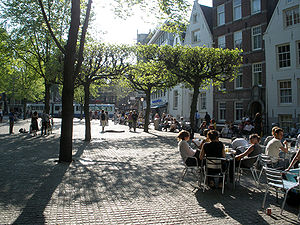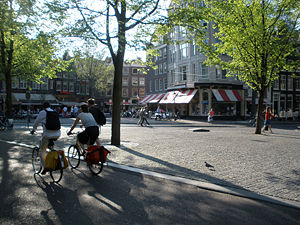.gif)
Spui (Amsterdam)
Encyclopedia


Amsterdam
Amsterdam is the largest city and the capital of the Netherlands. The current position of Amsterdam as capital city of the Kingdom of the Netherlands is governed by the constitution of August 24, 1815 and its successors. Amsterdam has a population of 783,364 within city limits, an urban population...
, The Netherlands. The Spui was originally a body of water that formed the southern limit of the city until the 1420s, when the Singel
Singel (Amsterdam)
The Singel is a canal in Amsterdam which encircled the city in the Middle Ages. It served as a moat around the city until 1585, when Amsterdam expanded beyond the Singel. The canal runs from the IJ bay, near Central Station, to the Muntplein square, where it meets the Amstel river...
canal was dug as an outer moat around the city. In 1882 the Spui was filled in and became the square that we know today.
In 1996 the square was renovated and is now largely car-free. Tram
Tram
A tram is a passenger rail vehicle which runs on tracks along public urban streets and also sometimes on separate rights of way. It may also run between cities and/or towns , and/or partially grade separated even in the cities...
lines 1, 2, 4, 5, 9, 14, 16, 24 and 25 stop at or near the Spui.
The Spui is a popular destination for book-lovers, with a weekly book market on Fridays and a variety of bookstores on or near the square, including two shops dedicated to English-language literature (the American Book Center relocated to the Spui in October 2006). There is also a weekly art market on the Spui, every Sunday.
A small statue, Het Lieverdje ("The Little Darling"), stands on the square. The statue represents the youth of Amsterdam, always playing pranks yet with a heart of gold. He was a gift to the city from a cigarette company in 1960. In the 1960s, the Provo counterculture movement held weekly gatherings around the statue.
The Spui provides entry to the Begijnhof
Begijnhof, Amsterdam
The Begijnhof is one of the oldest inner courts in the city of Amsterdam. A group of historic buildings, mostly private dwellings, centre on it. As the name suggests, it was originally a Béguinage...
, a Medieval courtyard.
Notable buildings
- The Maagdenhuis (1780), the headquarters of the University of Amsterdam.
- Arti et Amicitiae (1841), an artists' society and art gallery at the corner of Rokin and SpuiSpuiSpui is a Dutch term meaning a specific type of small sluice used for refreshing the network of waterways in a village or town. It may refer to the following things:*Spui, a river in the Netherlands...
, designed in part by BerlageHendrik Petrus Berlagethumb|120px|left|BerlageHendrik Petrus Berlage, Amsterdam, 21 February 1856 — The Hague 12 August 1934, was a prominent Dutch architect.-Overview:...
. - Gebouw Helios (1895-96) at Spui 15-19, in Art NouveauArt NouveauArt Nouveau is an international philosophy and style of art, architecture and applied art—especially the decorative arts—that were most popular during 1890–1910. The name "Art Nouveau" is French for "new art"...
style. The design by Gerrit van ArkelGerrit van ArkelGerrit A. van Arkel was a Dutch architect who designed many of Amsterdam's most prominent Jugendstil buildings....
won third prize in the architects' competition at the 1900 World's FairWorld's FairWorld's fair, World fair, Universal Exposition, and World Expo are various large public exhibitions held in different parts of the world. The first Expo was held in The Crystal Palace in Hyde Park, London, United Kingdom, in 1851, under the title "Great Exhibition of the Works of Industry of All...
in ParisParisParis is the capital and largest city in France, situated on the river Seine, in northern France, at the heart of the Île-de-France region...
. - The Oude Lutherse Kerk (1632-1633), the Old Lutheran Church, across the SingelSingel (Amsterdam)The Singel is a canal in Amsterdam which encircled the city in the Middle Ages. It served as a moat around the city until 1585, when Amsterdam expanded beyond the Singel. The canal runs from the IJ bay, near Central Station, to the Muntplein square, where it meets the Amstel river...
canal.

